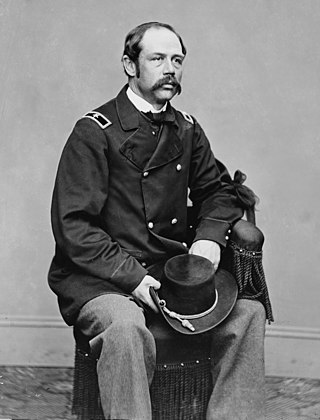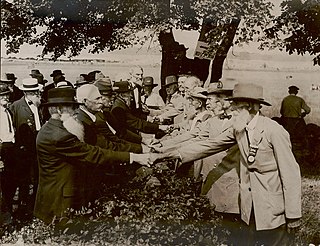
Gettysburg is a borough and the county seat of Adams County in the U.S. state of Pennsylvania. The Battle of Gettysburg (1863) and President Abraham Lincoln's Gettysburg Address are named for this town.

The United Service Organizations Inc. (USO) is an American nonprofit-charitable corporation that provides live entertainment, such as comedians, actors and musicians, social facilities, and other programs to members of the United States Armed Forces and their families. Since 1941, it has worked in partnership with the Department of War, and later with the Department of Defense (DoD), relying heavily on private contributions and on funds, goods, and services from various corporate and individual donors. Although it is congressionally chartered, it is not a government agency.

Gettysburg National Cemetery is a United States national cemetery created for Union casualties from the Battle of Gettysburg in the American Civil War. The Battle of Gettysburg, which was fought between July 1 to 3, 1863, resulted in the largest number of casualties of any Civil War battle but also was considered the war's turning point, leading ultimately to the Union victory.

The Gettysburg Battlefield is the area of the July 1–3, 1863, military engagements of the Battle of Gettysburg within and around the borough of Gettysburg, Pennsylvania. Locations of military engagements extend from the 4-acre (1.6 ha) site of the first shot at Knoxlyn Ridge on the west of the borough, to East Cavalry Field on the east. A military engagement prior to the battle was conducted at the Gettysburg Railroad trestle over Rock Creek, which was burned on June 27.

Camp Hale was a U.S. Army training facility in the Western United States, constructed in 1942 for what became the 10th Mountain Division. Located in central Colorado between Red Cliff and Leadville in the Eagle River Valley, it was named for General Irving Hale and was at an elevation of 9,200 feet (2,800 m) above sea level. Onslow S. Rolfe, who had developed mountain warfare techniques as commander of the 87th Mountain Infantry Regiment, was selected to command Camp Hale.

Helmut Flieg or Hellmuth Fliegel was a German writer, known by his pseudonym Stefan Heym. He lived in the United States and trained at Camp Ritchie, making him one of the Ritchie Boys of World War II. In 1952, he returned to his home to the part of his native Germany which was, from 1949 to 1990, the German Democratic Republic. He published works in English and German at home and abroad, and despite longstanding criticism of the GDR remained a committed socialist. He was awarded the 1953 Heinrich Mann Prize, the 1959 National Prize of East Germany, and the 1993 Jerusalem Prize.

The 28th Infantry Division ("Keystone") is a unit of the Army National Guard and is the oldest division-sized unit in the Department of Defense. Some of the units of the division can trace their lineage to Benjamin Franklin's battalion, The Pennsylvania Associators (1747–1777). The division was officially established in 1879 and was later redesignated as the 28th Division in 1917, after the entry of America into the First World War. It is today part of the Pennsylvania Army National Guard, Maryland Army National Guard, Ohio Army National Guard, and New Jersey Army National Guard.

Seminary Ridge is a dendritic ridge which was an area of Battle of Gettysburg engagements in July 1863 during the American Civil War (1861–1865), and of military installations during World War II (1941–1945).

Camp Atterbury-Muscatatuck is a federally-owned military post, licensed to and operated by the Indiana National Guard, located in south-central Indiana, 4 miles (6.4 km) west of Edinburgh, Indiana and U.S. Route 31. The camp's mission is to provide full logistical and training support for up to two brigade-sized elements simultaneously. The Camp offers a variety of training ranges, live-fire venues, managed airspace with air-to-ground fighting capabilities and an LVC simulation and exercise center. It is also the normal Annual Training location for National Guard and Reserve forces located in Indiana.
The Ritchie Boys were a special collection of soldiers, with sizable numbers of German-Austrian recruits, of Military Intelligence Service officers and enlisted men of World War II who were trained at Camp Ritchie in Washington County, Maryland. Many of them were German-speaking immigrants to the United States, often Jews, who fled Nazi persecution. They were used primarily for interrogation of prisoners on the front lines and counter-intelligence in Europe because of their knowledge of the German language and culture. They were also involved in the Nuremberg trials as prosecutors and translators.

George Henry Sharpe was an American lawyer, soldier, Secret Service officer, diplomat, politician, and Member of the Board of General Appraisers.

The 1913 Gettysburg reunion was a Gettysburg Battlefield encampment of American Civil War veterans for the Battle of Gettysburg's 50th anniversary. The June 29–July 4 gathering of 53,407 veterans was the largest ever Civil War veteran reunion. All honorably discharged veterans in the Grand Army of the Republic and the United Confederate Veterans were invited, and veterans from 46 of the 48 states attended.
Pitzer Woods is a Gettysburg Battlefield site used for Gettysburg Battlefield camps after the American Civil War such as the 1933–37 Camp Renaissance Civilian Conservation Corps camp.
The World War II Prisoner of War camp on the Gettysburg Battlefield operated from June 29, 1945, through April 1946 at the former site of the McMillan Woods CCC camp.
McMillan Woods is a Gettysburg Battlefield forested area used during the Battle of Gettysburg and for camps after the American Civil War, including a CCC camp and the subsequent WWII POW camp at Gettysburg. The woods includes Rifle Pits and Earth Works from the battle

The 1938 Gettysburg reunion was an encampment of American Civil War veterans on the Gettysburg Battlefield for the 75th anniversary of the Battle of Gettysburg. The gathering included approximately 25 veterans of the battle with a further 1,359 Federal and 486 Confederate attendees out of the 8,000 living veterans of the war. The veterans averaged 94 years of age. Transportation, quarters, and subsistence was federally funded for each veteran and their accompanying attendant. If an attendant was needed it was provided. President Franklin D. Roosevelt's July 3 reunion address preceded the unveiling of the Eternal Light Peace Memorial; a newsreel with part of the address was included in the Westinghouse Time Capsule for the 1939 New York World's Fair.
Greenmount is a populated place in Adams County, Pennsylvania, United States. It is located southwest of the Gettysburg Battlefield, at Marsh Creek along the Emmitsburg Road, in Cumberland Township.
Camp Renaissance was Civilian Conservation Corps camp NP-2 that was established on March 10, 1933, in the Gettysburg Battlefield's Pitzer Woods for reforestation. On September 22, 1933, Captain Moran transferred to Camp Renaissance to become the Company 1332 commander,. The camp with Company #385-C) in Pitzer Woods closed in April 1937.
The McMillan Woods CCC camp was Civilian Conservation Corps camp NP-2 on the Gettysburg Battlefield planned in September 1933 near CCC Camp Renaissance in Pitzer Woods. Captain Francis J. Moran moved from Camp Renaissance to become the new camp NP-2 commander in October 1933 The camp opened a new recreation hall in 1934 and provided manpower for building the veterans camp for the 1938 Gettysburg reunion, and about 50 enrollees of CCC Company #1355-C served as aides for unaccompanied veterans. During the reunion, Company F of the 34th Infantry used the CCC camp and had a headquarters office under Major C. Gilchrist and Capt. E. E. Wright. Captain Frederick L. Slade was the CCC commander on April 1, 1939.












